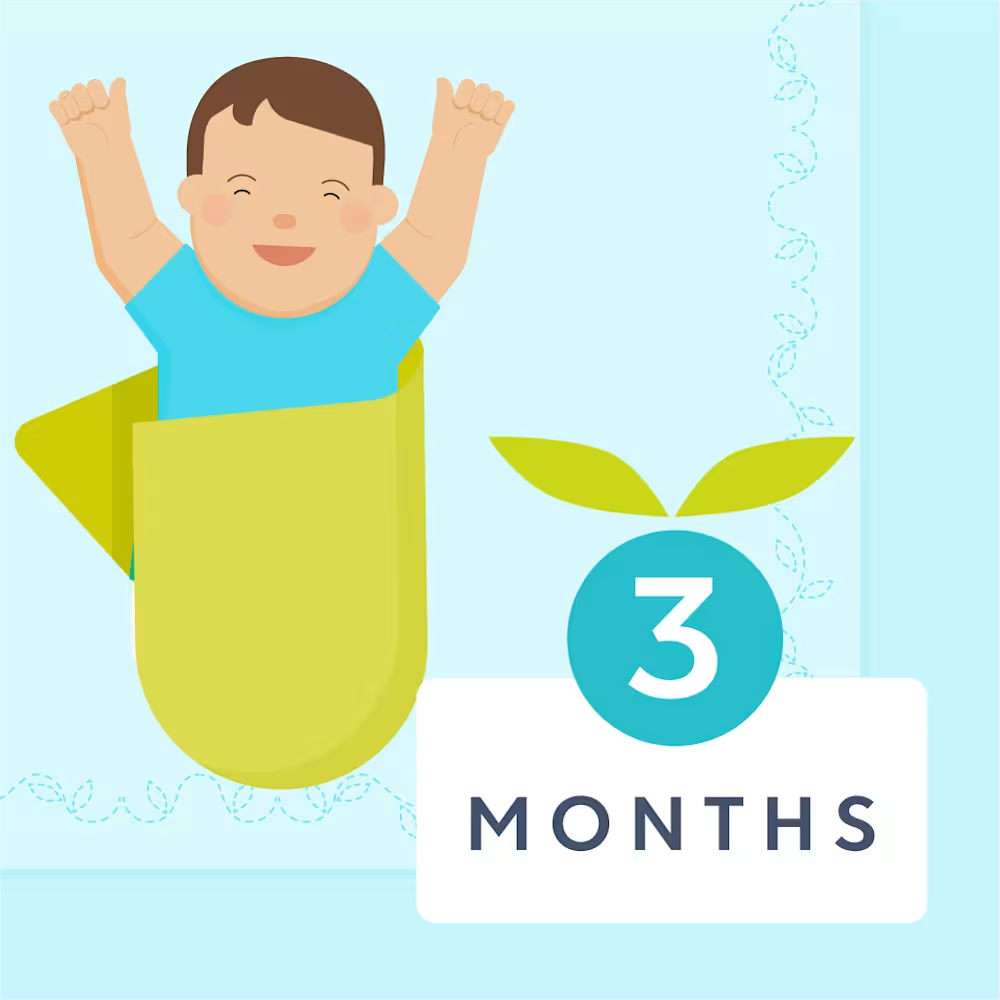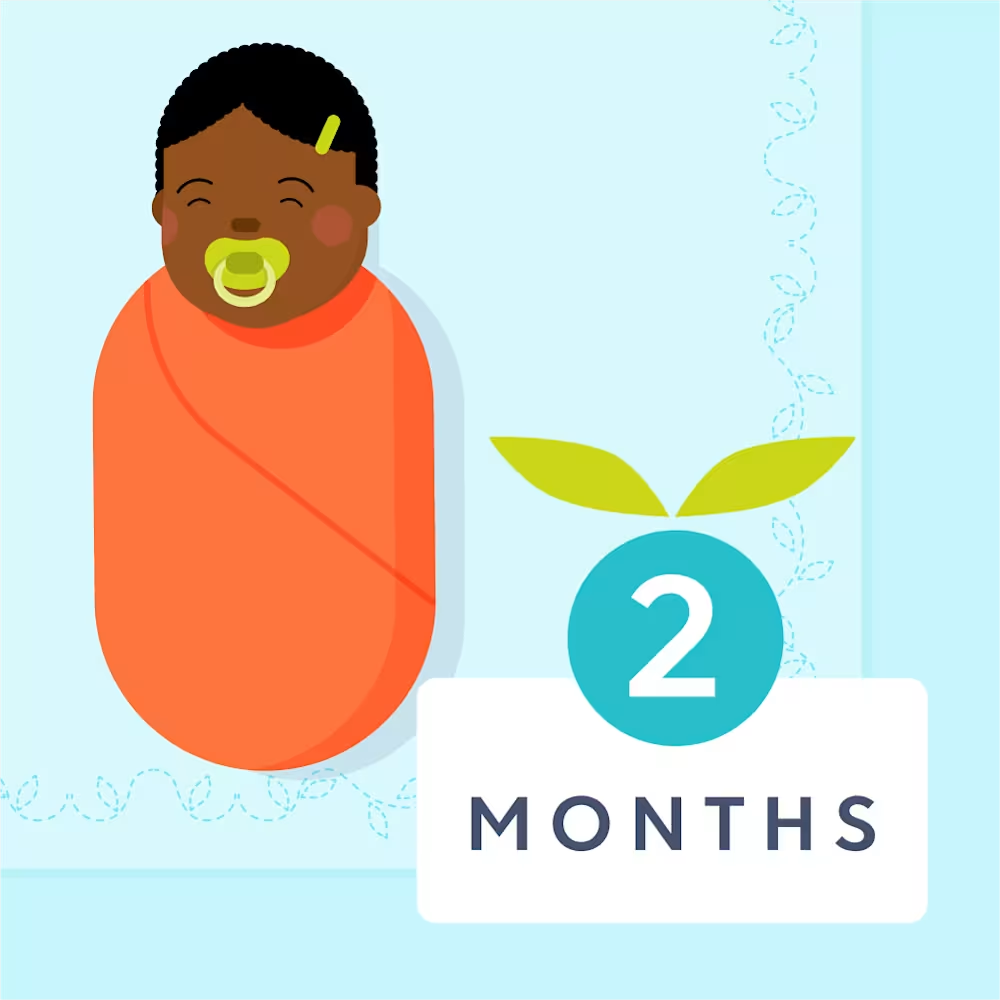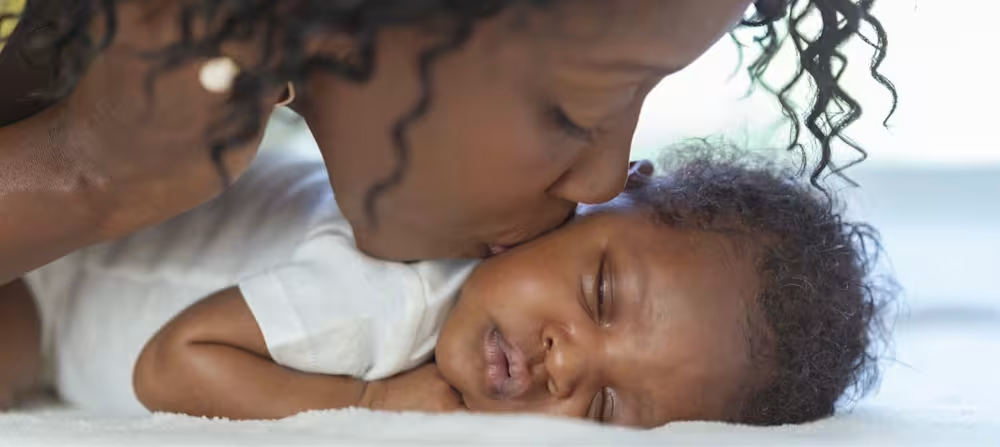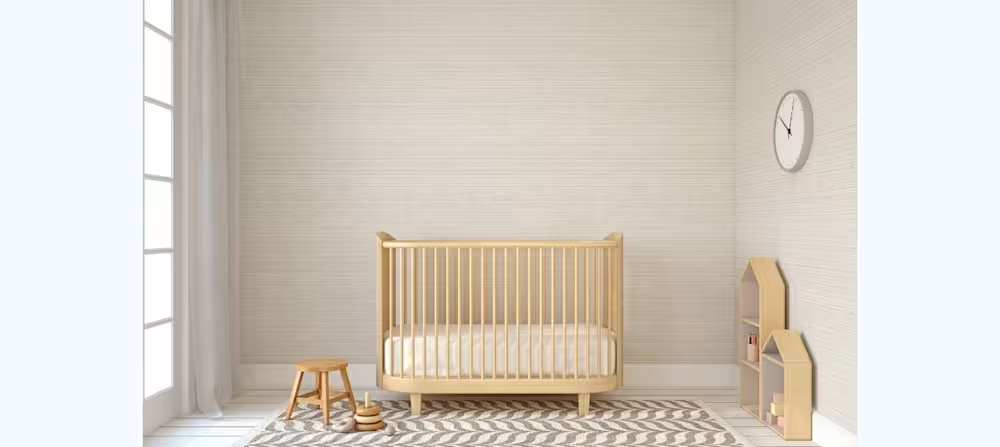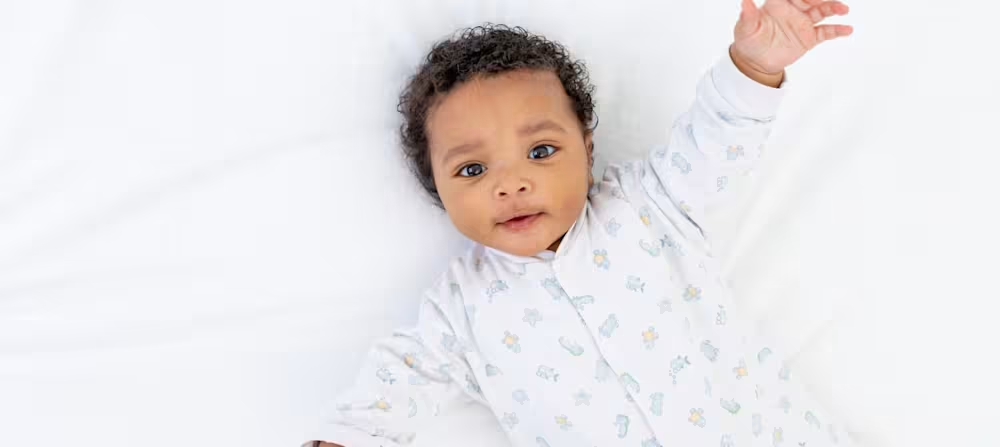3 month old baby milestones: Development, growth, speech, language
Updated Dec 29, 2025
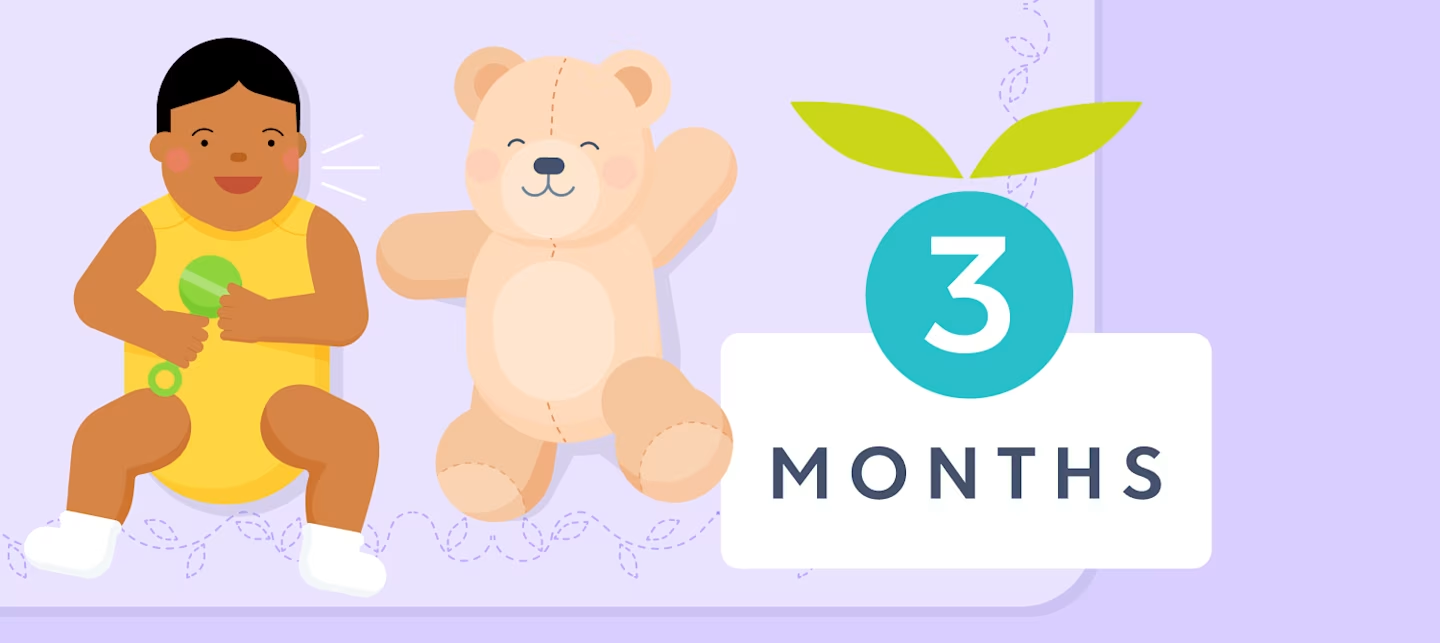
Between 3 - 4 months, it seems like babies are learning and growing before your eyes. They’ve already changed so much from those sleepy newborn days. At around 12 weeks your baby may become more expressive (with coos, cries, and smiles!), make eye contact, graspoven toys, and more.
In this article, we’ll take a closer look at the physical growth and social milestones you can expect from 12 week old babies, provide a useful 3 month old baby development checklist, and give you useful tips for your little one’s health and well-being.
Editor's note
When we discuss babies and development at Huckleberry, we use their adjusted age (vs. actual age). Keep in mind that not every baby will reach 3 month milestones simultaneously. Children develop and grow at their own pace, and while many reach these milestones between 12 and 16 weeks, this isn't always the case for everyone. Development is on a spectrum and it’s expected that babies reach milestones at different times. If you have any concerns about your child’s development, reach out to their pediatrician.
Table of Contents
3 month old baby milestones at a glance
Development:
Babies are developing in exciting ways between 3 - 4 months. At this stage, they’re working on new tummy time skills, kicking their legs, and might even be showing the first signs of getting ready to roll over. Their hands are busy too! Around 12 weeks, babies tend to learn how to open and shut their hands, bring them to their mouths, and even swipe at a dangling toy.
Typical 3 month old language development includes your little one’s first coos. Infants are learning to make and mimic simple noises at this stage. They are also learning to smile and make eye contact with familiar people. Prepare accordingly for cuteness overload!
Sleep:
Babies at need lots of sleep every day. We recommend aiming for around 15 hours [] total in a 24-hour period. This tends to break down into at least 10 hours overnight and 4 - 5 naps a day, though daytime sleep can still be irregular at 12 weeks.
You may start to notice that around 3 - 4 months old, your baby begins to experience cycles of light and deep sleep. This is because around 3 months, a baby’s circadian rhythm begins to mature. This "" occurs because babies wake fully between these cycles and need assistance falling back asleep.
Short naps are still common at this age. To help daytime sleep, continue to plan naps according to wake windows and sleepy cues (such as putting their head against you or staring off into space). Most babies are able to comfortably stay awake for 60 - 120 minutes before needing to sleep again. Overnight, babies at this age usually still wake up for feedings. Some families find it helpful to offer to maximize sleep during the night.
Keep in mind that the amount of sleep required varies from baby to baby, and there's a spectrum of what's normal and healthy. While suggested sleep hours offer a basic guideline, observing your child's mood and energy levels is equally important to gauge their individual sleep needs.
Feeding:
Breastmilk and/or formula provide all of your 12 week old’s nutritional needs and calories per day. At this age, most babies should be able to suck and swallow well during feedings. At this age, most babies need to eat every 3 - 4 hours during the day [] but can go for longer stretches at night.
? Between 0 - 3 months, babies usually consume 2 - 6 ounces per feeding. This increases to 4 - 6 oz around 4 months old. Consumption is a little trickier to gauge for breastfed babies, so consider making sure they have 6 or more wet diapers [] in a 24-hour period if you’re concerned your 3 month old isn’t eating enough.
Note that little ones also tend to “cluster feed” [] at this age, often as a result of a growth spurt. This means your 3 month old might want to eat more than usual (like every 30 minutes!), especially during certain times of the day. Luckily, infant growth spurts only tend to last 2 - 3 days.
Growth:
On average, 3 month olds will grow [] about 1 - 1.5 inches in length and gain about 1.5 - 2 pounds over the course of a month. However, babies grow at different rates and it can be normal for your little one to grow more or less than this between 12 - 16 weeks.
Your child’s healthcare provider will plot their height and weight during visits to ensure they’re growing at a regular pace and to identify any health trends that need attention. If you have concerns about your baby’s growth, consult their pediatrician.
3 month old development milestones
Physical development
Gross motor skills
Tummy time: At around 12 weeks, babies are getting stronger and making small movements independently during tummy time! Milestones at 3 months include starting to support their upper body with their arms along with raising their head and chest while positioned on their stomach.
Kicks: Typical 3 month gross motor milestones include leg movements too. Between 12 - 16 weeks babies start to stretch their legs out. You might even see them kick (watch out)!
Rolling: Little ones usually roll over at around 4 - 6 months []. But your baby might be showing signs of starting to roll earlier than that, around 3 - 4 months. If you notice any early signs of rolling (like your baby is reaching for toys while on their tummy), the American Academy of Pediatrics [] advises to stop swaddling your child for safety reasons.
Fine motor skills
Hands: By 12 weeks, babies often have very busy hands and will often spend a lot of time inspecting them and watching all the things they can do. Typical 3 month fine motor milestones [] include being able to open and shut hands, bring them to mouth, grasp toys, and swipe at dangling objects. Their sensory skills are developing too, helping them explore the world through touch and movement.
Communication
First sounds: Let the babbling [] begin! At around 12 weeks, your little one might begin making sounds other than crying. Typically 3 month language development looks like the start of cooing and imitating some very simple sounds.
Signaling hunger: A baby at 3 months is usually pretty good at signaling they’re ready for a feed. When hungry, typical behaviors [] include moving hands to mouth, rooting, or flexing arms and legs.
Crying: Crying can be an important communication tool for your 12 week old baby. Typical 3 month speech milestones include crying to indicate different needs [] — like they’re hungry, tired, or want to “play” more. By around 12 weeks, the phase of unexplained prolonged crying (aka “”) typically ends.
Social development
First social smiles: Babies tend to smile at the sound of your voice [] first and might even begin to smile at people around this age too. Remember to smile back! This helps you bond with your little one and makes them feel safe and secure.
Visual and cognitive development
Eye contact and face watching: Your baby at 3 months may “talk” with their eyes. Babies this age are starting to make eye contact and watch faces intently. Most little ones love to watch faces and facial expressions. Often they are also able to recognize familiar people and objects, even at a distance. Around 12 weeks, many infants can track moving objects with their eyes and turn their heads toward sounds []. These are signs of both visual and cognitive growth.
Developing color vision: At 3 months, your little one’s color vision is still coming online. They can likely see brightly colored objects, but may not yet distinguish softer pastels. High-contrast toys and books are great for visual stimulation now.
12 week old development milestones checklist
Remember not all 3 month old milestones will be reached by babies at the same time. Children learn and grow at different rates and while most typically hit these infant milestones between 12 - 16 weeks, this might not always be the case. If you have any concerns about your little one’s growth stages or see signs of potential baby development delays, consider having a conversation with their healthcare provider.
Feeding & physical development
Suck and swallow well during feedings
Raise their head and chest while doing tummy time
Support the upper body with arms while positioned on the stomach
Stretch and kick their legs out
Fine & gross motor skills
Grasp and bat at toys with hands
Open and shut hands
Communication & Social Interaction
Start to coo and make babbling sounds
Social smile
Make eye contact and watch faces intently
Follow moving objects with their eyes
Turn their head in the direction of a sound
See people and objects at a distance
What are 3 month development red flags?
While every baby develops at their own pace, here are a few signs around 3 - 4 months that may be worth discussing with your baby's healthcare provider []:
Baby doesn't smile socially (at people)
Can’t hold their head up or push their chest off the floor during tummy time
Not turning head to follow movement
Doesn’t bring hands to mouth
Doesn’t giggle or laugh when you try to make them smile
3 development tips for 3 month old babies
Tip | Why it helps | What to try |
|---|---|---|
Read and repeat | Repetition strengthens early language pathways and helps babies learn the rhythm of speech. | Read short books daily — even the same book on repeat. Let your baby listen to your voice, sing-song tones, and simple stories. |
Talk it out | Talking aloud supports early speech development and builds connection and familiarity with language. | Narrate your day: name objects, describe actions, and tell your baby what they’re doing (“We’re getting ready for bed now!”). |
Texture time | Exploring textures boosts sensory processing and helps babies learn through touch. | Offer safe, simple textures like a soft washcloth, crinkly fabric, or silicone toys, and let your baby explore at their own pace. |
Find more details below:
Tip #1: Read and repeat
Infants can benefit from reading, long before they can turn pages or follow along with a story. At this age, your baby enjoys hearing the sound of your voice and won’t mind at all if you read the same book over and over again. Babies love repetition! It’s good for brain development and helps them learn words eventually.
Tip #2: Talk it out
Baby activities don't have to be complicated! A great way to promote early speech development is by talking out loud to your little one throughout the day. Narrate what you’re doing, what you’re seeing, and name familiar objects. You can also tell your baby what they’re doing — taking a bath, getting ready for bed, etc.
Tip #3: Texture time
Exploring textures can help stimulate your baby's sensory system — touch is one of their first ways of learning about the world. Try gently introducing them to safe textures like crinkly fabric, a soft washcloth, or silicone toys, and watch how they react. Start simple!
Activities for a 3 month old baby
1. Smile and respond
Once your baby starts to smile at you at around 12 weeks, encourage them to keep up the good work by responding to them with a smile.
These exchanges are the first “conversations” you’ll have with your little one so get your camera ready!
This back-and-forth communication is important because it helps you bond [] with your baby and lets them know they’re safe and secure.
2. Use toys for tummy time
Tummy time is still an important part of your 3 month old’s day as it promotes their physical and visual development.
The American Academy of Pediatrics [] recommends that 12 week old babies spend a total of an hour per day in this position, broken up into small sessions.
Now that your baby has better hand-eye coordination, try incorporating toys into the routine to keep them entertained.
You might place a toy in front of them to encourage reaching and also shake a rattle to motivate them to use those tiny muscles to push and look up.
Caring for a sick 3 month old
At 3 months, it's still normal to worry about your baby when they're sick — even a stuffy nose can be stressful! Here are some general tips to help soothe your little one when they’re under the weather. Remember, if you notice any concerning symptoms or just feel like something’s off, don’t hesitate to call your baby’s healthcare provider. You know your baby best.
Hydrate: Breastmilk and formula are the main source of nutrition for your baby. Offer smaller, more frequent feeds if necessary if they're not tolerating full feeds while they're sick.
Ease congestion: If your baby has a , try using a cool-mist humidifier, gentle suction, and/or saline drops. Do what you can to clear up congestion before sleep times and offer extra support to ensure they get the rest they need.
Watch for fever: At 12 weeks and older, if your child has a fever for more than 24 hours or their temperature rises above 104°F (40°C) repeatedly, call their doctor right away [].
Be flexible with sleep: Babies need plenty of rest when they're sick, though it may be tricky if they have a stuffy nose or are uncomfortable. Your little one may need more sleep and/or have difficulty sleeping when they're not feeling well. Sleep may still be chaotic at 3 months and it may be even more unpredictable during an illness.
Offer extra comfort: Your baby may be even harder to put down while they're feeling yucky. This can be taxing for caregivers too! Tap in a partner or a close friend or family member when possible.
When to seek help
If your child has a fever for more than 24 hours or it reaches above 104°F (40°C), call their doctor right away. These can be signs of a more serious infection or illness and it's best to rule out anything that needs medical attention.
In general, if something feels off or you’re worried about how your child looks or acts, it’s safest to check in with their doctor. And if you already talked to them but symptoms appear worse, that’s a good time to check back in too.
Takeaway: Development milestones for 3 month olds
3 month olds are growing and learning about the world around them! Most babies are able to support their upper body with their arms at this age and have a different field of vision when this happens. They are learning to make eye contact with people and even smile at someone from across the room.
Between 12 - 16 weeks, little ones are working on fine motor skills like opening and shutting their hands as well as swatting at toys and grasping small objects.
At this age, babies might reach exciting social and language milestones like starting to babble and coo, social smile, watch faces intently, and turn towards sounds.
Note that these are general guidelines for 3 month old infant milestones. It’s perfectly normal if your child isn’t doing all of these things just yet since baby development is on a spectrum. That said, if you notice any red flags or have concerns about any development delays, consult with your child’s health provider.
If you're curious about what lies ahead in the next month, glimpse into the future to see what you might experience once your baby is a . Take a look back at how far your baby has come by revisiting what they may have been like as a .
3 month old development milestones FAQ
Share article:
Note: The content on this site is for informational purposes only and should not replace medical advice from your doctor, pediatrician, or medical professional. If you have questions or concerns, you should contact a medical professional.
16 Sources
Table of Contents
Share article:


